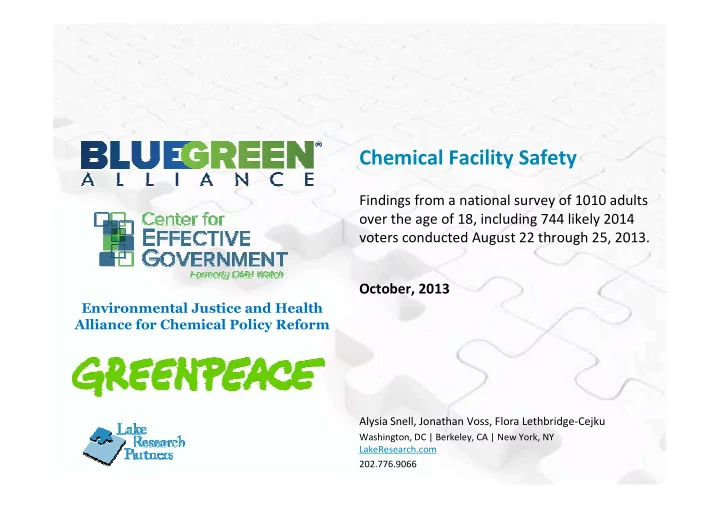

Chemical Facility Safety Findings from a national survey of 1010 adults over the age of 18, including 744 likely 2014 voters conducted August 22 through 25, 2013. October, 2013 Environmental Justice and Health Alliance for Chemical Policy Reform Alysia Snell, Jonathan Voss, Flora Lethbridge-Cejku Washington, DC | Berkeley, CA | New York, NY LakeResearch.com 202.776.9066
Key Findings • Voters strongly support a proposal to require chemical facilities to switch to safer processes. Importantly, the proposal enjoys strong bi- partisan support . Majorities of Democrats and Independents support the proposal, as do a plurality of Republicans. • Informing voters of the threat chemical facilities pose to local communities and the steps industry have already taken since 9/11 further increases the strength of support across party lines. Majorities overall strongly favor the proposal after learning more, and those voters who are initially undecided move disproportionately toward support. • Opposition argumentation falls flat. Attempts to paint the proposal as an unnecessary regulation that would cost jobs and increase prices do not work . Almost 60 percent of voters believe we need to do more to protect communities from high-risk chemical facilities; only 22 percent believe more regulation is unnecessary and too expensive. 2
Voters strongly favor requiring chemical facilities to use safer chemicals and processes when they are effective, available and affordable. To prevent explosions or major release of poisonous gases, do you favor or oppose the Federal government requiring chemical facilities to use safer chemicals and processes when they are effective, available, and affordable, or are you undecided? All Likely Voters 3 Strongly Favor Not So Strongly Favor Strongly Oppose Not So Strongly Oppose
Strong support for the proposal extends across party lines and demographics groups. To prevent explosions or major release of poisonous gases, do you favor or oppose the Federal government requiring chemical facilities to use safer chemicals and processes when they are effective, available, and affordable, or are you undecided? Oppose Favor Strongly Favor Not So Strongly Favor Strongly Oppose Not So Strongly Oppose 4
Informing voters on the risks to local communities and the fact that hundreds of facilities have already switched consolidates support. KNOWLEDGE OF COMMUNITY IMPACT KNOWLEDGE OF CONVERTED FACILITIES Currently high-risk chemical facilities threaten Since 2001, over 600 chemical facilities have the safety of more than 100 million Americans switched to safer chemicals and processes to who live nearby. eliminate the possibility of a disaster in the event of an accident or terrorist attack. Given this, do you favor or oppose the proposal? 5 Strongly Favor Not So Strongly Favor Strongly Oppose Not So Strongly Oppose
Voters reject the suggestion that switching to safer processes is a burdensome regulation that would cost jobs and increase the price of goods. Which statement do you agree with more? We must do more to protect the safety and security Requiring chemical facilities to switch processes of millions of Americans by requiring high-risk is unnecessary government bureaucracy and too chemical facilities to switch to safer processes and expensive. We cannot afford new burdensome chemicals when they are available, effective and regulations that cost businesses money, raise the affordable. 600 facilities have already done so, prices of goods for consumers, and threaten to proving that businesses can be both profitable and cut thousands of jobs. safe. 8%, Both 6 5% Neither 6% Don’t know/refused to answer
Methodology • Lake Research Partners designed this survey, which was administered by Caravan in an omnibus survey conducted by telephone using professional interviewers. The survey reached a total of 1,010 adults nationwide in the continental United States (650 by landline, and 360 by cell phone) . The survey was conducted from August 22-25, 2013, and has a margin of error of +/- 3.1% at the 95% confidence interval. The margin of error is higher among subgroups. • The survey included screening questions to determine if people were registered and likely to vote in the 2014 elections. The survey reached a total of 744 likely 2014 voters and has a margin of error +/- 3.6% at the 95% confidence interval. The margin of error is higher among subgroups. • All numbers represent subgroups of likely voters. 7
Washington, DC | Berkeley, CA | New York, NY LakeResearch.com 202.776.9066 Alysia Snell asnell@lakeresearch.com Jonathan Voss jvoss@lakeresearch.com Flora Lethbridge-Cejku flethbridgecejku@lakeresearch.com
Recommend
More recommend